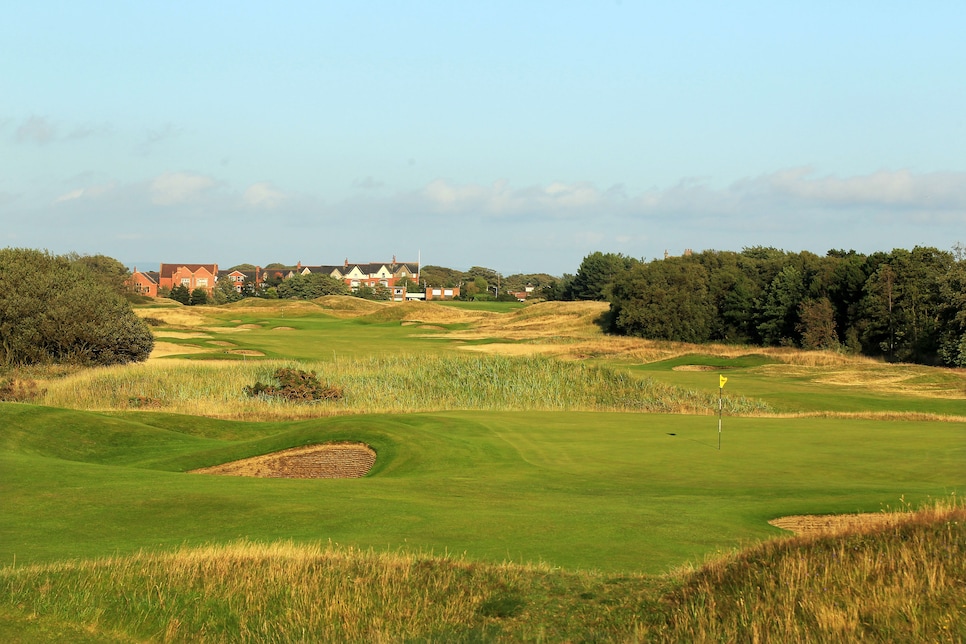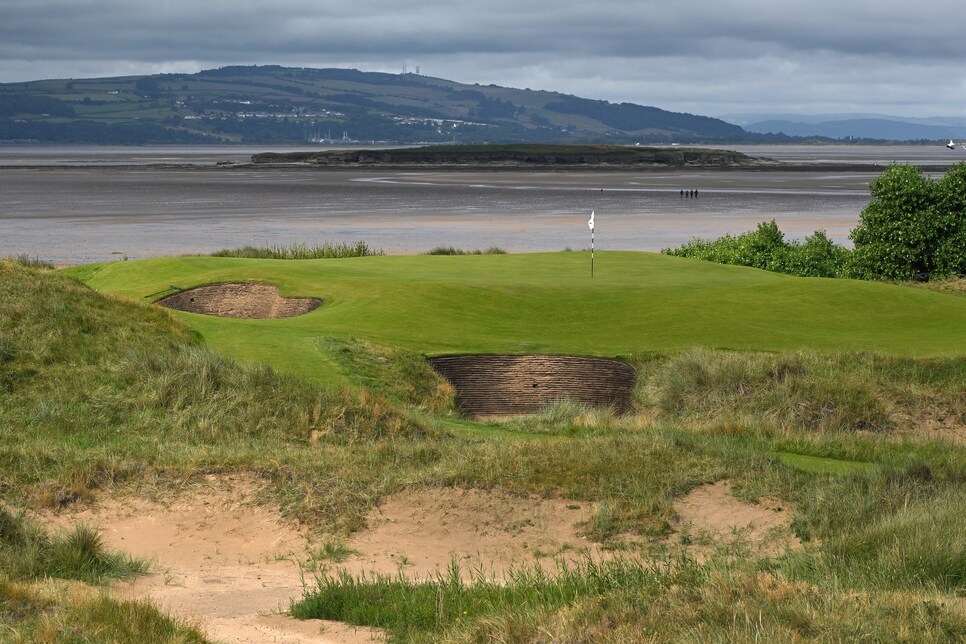American golf course architects have been renovating courses in preparation for US Opens and PGA Championships since the years following World War II. Major championship alterations were a vital element of how Robert Trent Jones and, later, his son Rees Jones, built their names into global brands. More recently Gil Hanse (with partner Jim Wagner) and Andrew Green have achieved similar notoriety for prepping places like Oakmont, Los Angeles Country Club and Oak Hill.
British architect Martin Ebert has provided the same service to the majority of the Open Championship venues in the United Kingdom, though with less fanfare, at least to US audiences. Ebert worked extensively with Royal Portrush in Northern Ireland prior to the 2019 Open, implementing a series of major changes to address some of the course’s perceived tournament shortcomings.
Considering that the championship hadn’t been played outside Scotland or England since 1951 when it also crossed the sea to Portrush, the revamped design provided a jolt of new energy into the traditional rotation of courses. Shane Lowry ran away with the claret jug, winning by six strokes, but Portrush’s Dunluce Links course also won by showing off evocative emerald hues, wild dunes, a blufftop setting overlooking the North Atlantic and Ebert’s modifications, including two newly created holes.
These same characteristics will be on display when Portrush hosts The Open for the third time beginning next week.
Ebert, 58, has spent the past 20 years, along with design partner Tom Mackenzie, refining his expertise as one of the most sought-after and visionary renovation specialists in the profession. He played golf at Cambridge where he studied engineering and became increasingly interested in golf courses, playing in matches and, later, on a tour with his team of prominent US courses including Merion, Shinnecock Hills, Pine Valley and Maidstone.
Ebert met Mackenzie when he was invited in 1990 to join the firm of veteran architect Donald Steel, who was becoming increasingly busy and in need of help. With no training in golf design, Ebert leaned on his background studying engineering. Over the next 15 years he and Mackenzie helped Steel build courses across the UK and North America. In 2005, as their mentor wound down his active design career, they founded their firm, Mackenzie and Ebert.
In the time since they’ve prepped eight of the 10 regular rota courses for Open Championships, with only St. Andrews and Muirfield as outliers (at least for now). Their work for each club ranges from standard programs of tee lengthening and bunker reconstruction to wholesale alterations of course routings, including the construction of novel holes.
Ebert emphasises that his renovation jobs begin with the individual clubs hiring the firm to enhance or update the design and infrastructure for everyday play—he does not work for the R&A, who oversees the Open Championship. But inevitably the jobs for rota courses conclude with a study of how the holes will best challenge the professionals during major championships.
“It’s very much a three-way process with each club, the Royal & Ancient and ourselves,” Ebert says. “There’s a lot of dialogue between us all, and there are a lot of visits to be made to really look at things on the ground before we consider any proposal, or any plans are drawn up.”
Whatever proposals Ebert makes, they’re based on a variety of weighted factors: how the renovation will enhance member experience; scoring data accumulated from previous tournaments; extensive research of the course’s historical origins and changes; traffic plans for spectators, maintenance and hospitality; agronomic needs; advances in club and ball technology; and other variables.
“Any changes to the design have got to be beneficial to the club 99 percent of the time, but they’ve obviously got to work for the Open as well,” he says.
In addition to Open rota courses, Mackenzie and Ebert have completed remodels at places like Hirono in Japan (ranked No. 26 in the World’s 100 Greatest Courses), Royal Porthcawl in Wales, (No. 43), St. Andrews’ New Course (No. 91) and Nairn (No. 95) in Scotland, Princes in Kent and Royal Copenhagen. They’ve also consulted at Royal County Down (No. 1), Royal Dornoch (No. 2), Royal Cinque Ports (No. 79) and revived the starkly minimalist links of Askernish on Scotland’s remote Outer Hebrides.
Ebert’s first official Open consultation was with Turnberry (now Trump Turnberry) prior to the 2009 Open, a club with which he formerly worked with as an associate with Steel (Steel also consulted with Royal St. Georges, though Mackenzie and Ebert won an open bid to renovate the course before the 2011 Open).

Ebert’s renovation work includes a new par-3 11th hole on the Ailsa Course at the Trump Turnberry Resort.
David Cannon

Ebert converted the sixth hole (green foreground) to a par 4 at Royal Lytham while lengthened the par-5 seventh (back).
David Cannon

A general view new par-3 at Royal Liverpool built by Ebert that played as the 17th hole during the 2023 Open. Stuart Franklin/R&A
The enhancements for the 2009 Open at Turnberry were important, but it wasn’t until several years after the event that Ebert was able to undertake more comprehensive changes that redefined the Ailsa Course’s coastal holes along its northwestern edge, some of the greatest golf real estate in the world. He broke up the existing ninth, 10th and 11th holes to create a new par-3/par-5/par-3 stretch, shifting them farther out against the rocky bluffs to catapult over sections of Castle Port Bay.
This ability to see architectural possibility beyond the status quo—and the willingness, or courage, to make significant changes to hallowed links ground—has defined Ebert’s career.
It continued at Royal Lytham & St. Annes where he and Mackenzie were awarded the job of strengthening the design for the 2012 Open. Among the alterations was the conversion of the par-5 sixth to a par 4 and lengthening the seventh into a par 5 with a new green. Several dozen bunkers have also since been removed and converted to grass swales.
At Royal Liverpool, Ebert believed the club’s short par-3 13th playing from the edge of the estuary eastward into the heart of the course could be enhanced. With the club’s consent, he flipped the direction of the hole, which played as the 17th for the 2023 Open, to go west toward the sea, elevating the aesthetics and creating a magnificent view while also giving it more backbone due to the pin cushion-sized green surrounded by sand and deep hollows.
Ebert and Mackenzie’s use of three-dimensional, computer-generated images (CGI) have been invaluable in conveying their ideas and proposals to clubs. Their team can create realistic video flyovers that are accurate down to the smallest of contours, providing perhaps skeptical members life-like perspectives of what the new holes and reformations will look like, including the distant 360-degree views and cross-property perspectives.
CGI was particularly helpful at Portrush as the club, the architects and the R&A considered abandoning the 17th and 18th holes and replacing them with two that would have to be conjured. Even though the 17th and 18th were part of the original 1932 design from legendary architect Harry Colt, they were located on the opposite side of the clubhouse, away from the rest of the course, and travelled out and back across less inspired ground.
“Some people used to call Portrush the best 16-hole course in the world,” Ebert says.

Ebert poses with his bicycle during the third round of the 2019 British Open at Royal Portrush. He used the bike, a gift from club secretary Wilma Erskine, every day while designing the new seventh and eighth holes on the Dunlace Course. (IMAGE CREATED USING A CONVERTED INFRARED CAMERA)Charles McQuillan/R&A
The first step to strengthening the tournament bona fides was to establish that it would not be sacrilegious to alter the Colt routing.
“There was still that challenge to convince the membership that it was in their interest, and [the modifications] weren’t going to denigrate Colt’s great legacy,” Ebert says. “That’s where the historical research is so invaluable to us. We discovered that when Colt made his design back in 1930, the clubhouse was in the town, in an area just west called the Triangle. When the clubhouse moved to its current location in 1939, two of Colt’s holes were lost.
“So Portrush had already lost two of his holes when the clubhouse moved, and those were replaced by the current 10th and 11th, built not by Colt but by the then club professional. Colt actually approved of the changes. He said, ‘why hadn’t I thought of that?’. We made the case to the club that the precedent had already been set.”

An example of Ebert using CGI technology was showing Royal Portrush this old image of the landscape that would be used for the new eighth hole on the Dunlace Course …

… and then showing them this CGI rendering of what it would become. (Courtesy of Mackenzie and Ebert)

A view of the new par-4 eighth hole at Royal Portrush, designed by Martin Ebert ahead of the return of the Open to Northern Ireland in 2019.
David Cannon

A view of the green of the new par-5 seventh hole at Royal Portrush, designed by Martin Ebert ahead of the return of the Open to Northern Ireland in 2019.
David Cannon
The replacement holes, the par-5 seventh and dogleg left par-4 eighth, were situated partly through an unused section of dunes west of the sixth green that Ebert describes as “God-given ground,” and partly over two holes of the club’s Valley Course (he built two new holes elsewhere on the Valley’s land to replace them). In character and challenge, they are seamless additions. Ebert believes that missing in the dunes left of the eighth is now one of the least desirable places to be at Portrush.
In addition to new tournament tees and the new holes, a number of fairway bunkers were added and adjusted (Portrush still has less than 60 bunkers, a small number compared to most Open courses) and three greens were reshaped to better match them to the voluptuous Colt contours found on the other putting surfaces. The par-5 second was also lengthened by building a new green 40 yards beyond the existing one.
The ability to use images and the CGI flyover to model the alterations was invaluable in projecting how the course would look and play. “I think the membership were happy that the changes would be appropriate for Portrush, and they could see the new holes would be really good ones,” Ebert says.
That trust was borne out during the successful 2019 Open and is reflected in the design’s overall reputation that now finds it ranked fourth in the world.
A similar remodeling program has taken place at Royal Birkdale, site of the 2026 Open. The club asked several architecture firms to propose changes to its troubled par-4 fifth hole and subsequently hired Mackenzie and Ebert to oversee that remodel as well as a number of other significant changes (Tom Mackenzie is leading the Birkdale renovation). These include the conversion of the old par-3 14th to an expanded part of the practice area and the creation of a new par 3 (the 15th) between the old 15th and 16th holes.
But for now, all eyes are back on Royal Portrush. For architects, there’s no greater reward—or marketing—than for the work to be broadcast around the world. That kind of exposure has made designers like Hanse and Green among the most sought-after in the US, where virtually every club and developer wants to be associated with them. The same is true for Ebert, in Europe and beyond. The proof is in the product. The phone keeps ringing.




